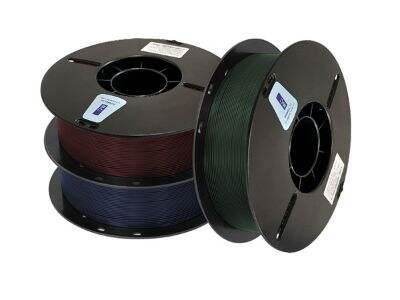Dowell 3D fuit mirabilis societas quae res conficiebat utendo impressoribus 3D. Huiusmodi impressores possunt omnia genera rerum ex initio creare, ponentes stratas materialium super invicem. Dowell 3D imprimit utendo variis materialibus, dependente ab eo quod necessarium est. Selectio materialis est crucialis, quoniam determinat vim aut flexibilitatem rei finalis. Ei filum normale et filamentum fibrae carbonis . Distinctio inter duas materias esse potest valde utilis cum de cōnsiliō quod rectum est pro data impressione 3D.
Filamentum Normāle
Filamentum normāle utītur speciāli genere plasticī quod vocātur PLA (polylactic acid). Hoc est valde facile tractāre, quod eum populārem inter principiantes facit. Habet temperatūram mōllem, itaque non multum caloris opus est ad imprimendum. PLA connectit formam claram sine contrāctiōne dum imprimitur, quod est aliud praeclārum factum de PLA, tamquam filamentum fidum. Praeterea, PLA est amīcum naturae quia fit ex naturalibus, renovābilibus rēbus, sicut farinā tritici et saccharo. Filamentum normāle est optimum his qui novīs sunt ad imprimendum 3D, quia est facile utī et parvum in pretiō.
Filamentum fibrae carbonis
Ex contrario, filamentum fibrae carbonis est materia praestans quae magis apta est ad usus specialis. Hoc genus filamenti est ligamen quod continet et plasticam et fibras carbonis. Fibra carbonis multo potentior et durabilior est quam filamentum normale, permitte creationem impressionum quae possunt sustinere conditiones asperas. Fibræ carbonis sunt valde fortes et addunt rigiditatem impressionibus finalibus. Filamentum fibrae carbonis est materies fortis et late utitur in fabricando instrumentis quae requirunt multam firmitatem, sicut partes productivæ designatæ ad usum in carribus, avionibus, instrumentis medicinariis, etiam robotibus. Quod eam optime reddit ad usus speciales qui requirunt projecta seria ubi qualitas et fortitudo designis necessaria est.
Virtutes et Vitia Filamenti Fibrae Carbonis
Cum ratione mirabili fortitudinis ad pondus, fibra carbonis filamento 3d potest potentia offerre unum ex utilissimis characteribus in thermoplastis. Quod hoc significet est, quod extremum est fortitudine, sed etiam valde levis est. Hoc facit eum valde aptum pro structuris, quae oportet esse leves et simul rigidae. Eius fortitudo est consequentia modi, quo fit. Omnes combinat fibras carbonicas cum basi plastica, faciens productum finale et rigidum et durum.
Sed filamentum fibrae carbonicae non caret suis difficultatibus. Invenimus, quod unus defectus est, quod potest esse difficilius ad operandum quam filamentum standard. Propter eius rigiditatem et fragilitatem, potest frangi vel scindere sicut vitrum, si non tractatur leniter durante processu impressionis. Itaque quisquis utitur filamento fibrae carbonicae debet magis curam habere in processu impressionis. Una alia difficultas est, quod filamentum fibrae carbonicae potest esse carius quam filamentum commune. Filamentum fibrae carbonicae plus costa producere, quia requirit plura materiales pro processo.
Quomodo Fibra Carbonis Permittit Imprimendum
Nihilo praetermissum his difficultatibus, filamentum fibrae carbonis significativam praebebit inventionem in operatione impressionum FDM. Fibrae carbonis robur addunt, imprimendum multo firmitius et resistens magis ad usum. Hoc est necessarium in applicationibus industrialibus quae partes impressas 3D in exigentibus locis utuntur. Haec membra magnas debent sustinere tensiones et vires sine frangendo.
Fibra carbonis, in speciali, qualitatem impressionis firmare potest. Possibilitatem minuit distorcionis vel mutationis dum imprimitur. Addita supportatio fibrae carbonis ab eis retinet ut non moveatur vel circumferatur dum frigescit. Quod significat quod finis sit magis conformis intentioni.
Comparatio Pretii VS Aeternitatis
Cum de filamentis standardibus versus filamentis fibrae carbonis cogitas, sunt paucula importantia consideranda. Alii aspectus includunt pretium, durabilitatem, et finitionem.
Quod attinet ad expensas, filamentum standard costa significative minus quam filamentum non fibra carbonis. Hoc significat filamentum standard esse multo economicalius pro principiantibus aut projectis minoribus qui non necessario indigent multa fortitudo. Filamentum fibrae carbonis, licet carius, praebet meliorem fortitudinem et durabilitatem. Itaque, id est optima electio pro projectis commercialibus requisitis materialibus altissimis.
Ex eius proprietate durabilitatis, filamentum fibrae carbonis vere supereminet. Propter incrementam rigiditatem quam fibracula carbonis praebent, impressiones filamenti fibrae carbonis sunt multo durableiores et sustinebunt usum diuturnum praecipue in ambiente aspero. Hoc etiam facit partes minus fragiles aut deteriores fieri cum tempore per usum fibrae carbonis.
Sunt etiam differentiae in finitione. Standard filament impressiones tendunt habere levigatiorem et lucidam superficiem. In altera parte, carbon fiber filament impressiones ostendunt asperam superficiem. Hoc dat impressionibus finalibus qualitatem texturam quam multi laetantur, propter carbonum fibras.
Quomodo Carbon Fiber Mutavit Technologiam Impressorum 3D
Additio carbonis fibrae FDM ad scenam impressorum 3D significat maiorem mutationem. Prima vice, Dowell 3D potest fabricare partes altius performantes per combinationem proprietatum physicarum materialium carbonis fibrae, quod est magnum, et faculatem et usum facilem, quod bene fit ab imprimante machina FDM. In campis sicut applicationes automotivae et aerospaciales, implantationes medicinales, et prostheses, haec technologia adoptatur. Totaliter perturbat modum quo industriae conceptuant fabricationem et designum suorum bonorum.
Praeterea, haec technologia scanning 3D aperit optiones infinitas pro designeribus et ingeniis. Ei licet elaborare producta et solutiones ad mensuram quae congruunt perfecte cum requisitis uniuscuiusque applicationis. Quod attinet ad FDM printing fibrae carbonis, imaginationes designerum sunt unica limita. Facit ut eas ideas et designios quos antea non poterant creare concipere possint.
Summaria dicendo, intellectus distinctionum inter typicum et filamentum fibrae carbonis 3d FDM printing est necessarius ad eligendum materiam rectam pro projecto certo. Filamentum commune valet bene pro initiis et projectis in minore scala, dum filamentum fibrae carbonis est validius, robustius, et in communi dat tibi meliorem operationem. Itaque, hoc est optimum et ultimum optionem pro applicationibus industrialibus et advanced. Dowell 3D magnopere laudatur ut offert tam filamentum commune quam filamentum fibrae carbonis. Hoc facit ut clientibus nostris liceat elegere materiam convenientissimam ad satisfaciendum suis necessitatibus, eos habilitando ad consequendum optimos resultatus printing 3D.

 EN
EN
 AR
AR
 BG
BG
 HR
HR
 DA
DA
 NL
NL
 FR
FR
 DE
DE
 EL
EL
 HI
HI
 IT
IT
 JA
JA
 KO
KO
 PT
PT
 RU
RU
 ES
ES
 SV
SV
 TL
TL
 ID
ID
 SR
SR
 SK
SK
 UK
UK
 VI
VI
 ET
ET
 HU
HU
 TH
TH
 TR
TR
 MS
MS
 GA
GA
 BE
BE
 HY
HY
 KA
KA
 LO
LO
 LA
LA
 MN
MN
 NE
NE
 SO
SO
 MY
MY
 KK
KK
 UZ
UZ
